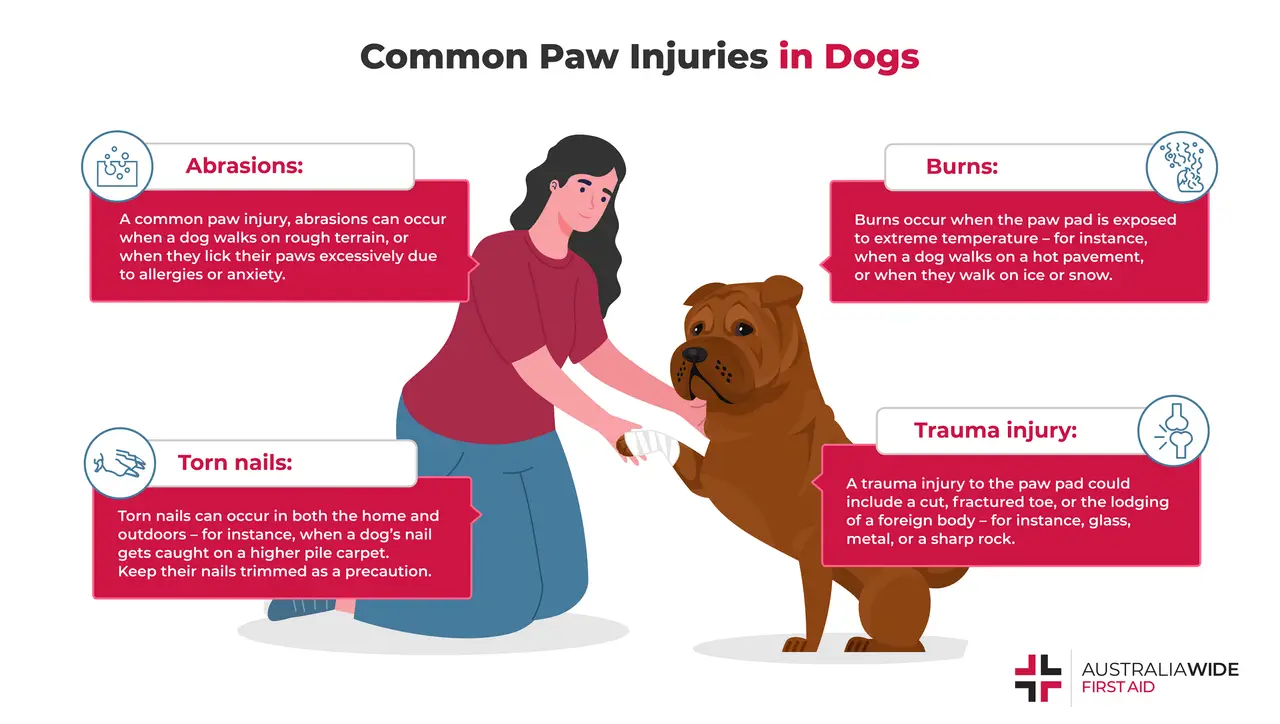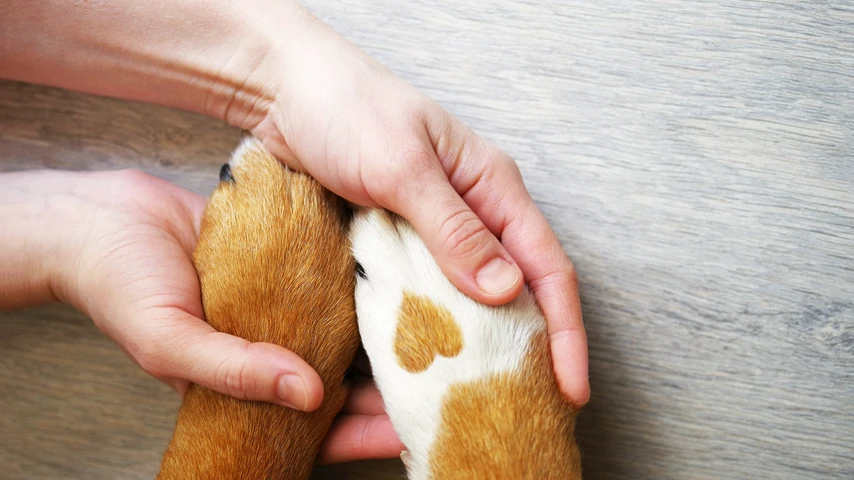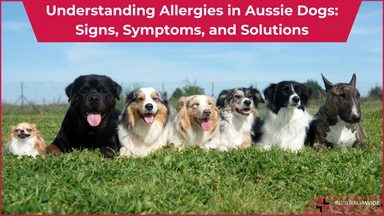First Aid for Dogs: Paw Care


A dog’s paws are tough, but injuries happen.
Learning how to treat common paw injuries using basic first aid will empower you to manage your dog’s injuries with confidence and know when to seek professional help.
Some paw injuries are obvious. You may hear your dog yelp in pain from an acute traumatic injury. Other times, the injury reveals itself later when he begins to limp or lick his paws excessively. Below we will review common dog paw injuries as well as the symptoms and first aid treatment for each.
Abrasions to paw pads can occur for various reasons, so it is a common injury. Walking on rough terrain can cause small scratches and surface injury. Excessive licking from allergies or anxiety can also abrade the paw pads.
Burn injury occurs when the paw pad is exposed to extreme temperature. It is very common in the summer when pavement temperatures soar. Interestingly, burns can also occur when the pads are exposed to very cold temperatures when walking on ice or snow.
This type of injury occurs often at home as well as on the trails and outdoors. Carpet is a common cause of nail injury, particularly higher pile carpet. Keeping your dog’s nails trimmed helps to prevent this type of injury.
A trauma injury to the foot pad could be a cut injury, a fractured toe, or the lodging of a foreign body. Common foreign bodies that get lodged into the foot pad include glass, metal, sharp rock, cactus needles, thorns, and foxtail seed.

Apply a non-stick pad to the site of injury. Apply padding and pressure over the injury to stop bleeding. Wrap the affected foot in a figure-8 pattern.
If you have multiple wrapping items on hand, wrap the foot first with gauze, then with a stretch material over the top. Apply tape over the bandage to stabilize the wrap.
When wrapping the foot, push the foot into its weight-bearing position so that the wrap is stabilized and not too tight when the foot returns to its natural standing position.
Some wounds and injuries can be prevented with a little preparation. If you plan to take your dog on an extended trail hike, precondition the paw pads to rough terrain to toughen up the pads. Keep the nails well-trimmed and regularly condition your dog to nail trimming practices.
In the heat of summer take walks in the early morning or evening to avoid hot pavement. Modify or shorten walks over snow and ice to avoid cold injury. Consider introducing your dog to booties that cover and protect the paw pads. Do not introduce the booties on the trail when they are immediately necessary.
Your dog will likely need time to acclimate to boot-wearing. While boots can protect your dog’s paws, they can also hide injuries. Take care to inspect your dog’s paws regularly during boot use. Keep a first aid kit on hand during longer trail hikes or when you will be away from home.
Conservative management of paw injuries in the field or at home is encouraged. In the case of injury, implement the first aid techniques described above and seek professional help as needed.
Most paw injuries can heal on their own without the need for surgical intervention. Time and rest are the most valuable healing techniques.
In the following cases, you should consider seeking professional veterinary care:
Don't forget, the most important factor in keeping your dog safe is you. To learn how to avoid injuries while out exploring with your furry friend, book a First Aid course with us today!

April 16, 2024
Like humans, our canine friends are susceptible to allergies, which can significantly affect their quality of life. This article aims to shed light on common allergies in dogs, their signs and symptoms, treatment options, and advice on when to consult a veterinarian.

March 19, 2024
From respiratory distress to changes in droppings and abnormal behaviours, this guide outlines the key indicators of illness that require immediate attention. By understanding these warning signs, bird owners can take proactive steps to ensure their feathered companions receive timely medical treatment, ultimately promoting their health and well-being.

February 12, 2024
In the hustle and bustle of our daily lives, it's easy to overlook that our furry friends may not be leading lives as fulfilled as we'd like. Just like humans, dogs too can suffer from monotony, especially those spending large amounts of time indoors. Recognizing and addressing boredom in our canine companions is crucial for their overall well-being.